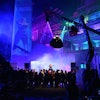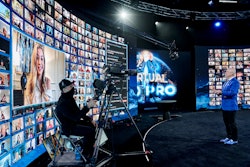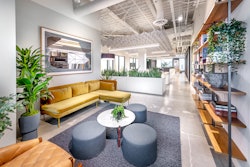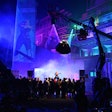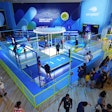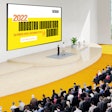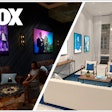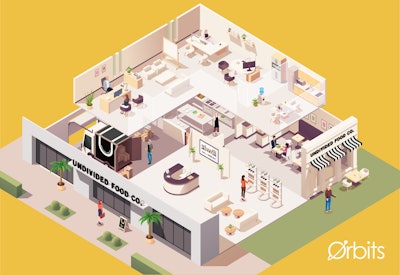
One thing’s for certain: The line between virtual and in-person will stay blurred for the foreseeable future, with a rise in hybrid events that allow attendees to join however they wish. But what about offices, another gathering place that tends to rely on in-person meetings and face-to-face camaraderie?
As companies question the value of telework versus an in-person office, Sydney, Australia-based virtual event platform Orbits may have a solution: the hybrid office. How it works: Orbits can create a branded, virtual office that replicates a company’s brick and mortar counterpart and is accessible by both remote and in-office workers. The goal is to allow employees to feel a part of the fabric of the team while working remotely—and for companies, it allows them to connect all of their employees around the world into one virtual space.
To learn more, BizBash chatted with Nena Salobir, Orbits’ co-founder and chief creative officer.
Can you tell me a bit about Orbits' mission and what you’ve been up to since launching in 2020?
We’ve been on a mission to breathe some enjoyment and meaning into all the new virtual layers of our lives. As humans, we derive so much from our surroundings. Walking into a flashy office makes us stand up straight, puff our chests out and behave like the stakes are high. Taking out a notebook in a cafe with a warm ambiance gives us a sense of relaxed purpose. All of these contextual cues—foregrounding the task or experience at hand—are lost in a standard virtual meeting or webinar. The Queen experiences the same visual cues as a toddler in a playgroup.
We actually designed Orbits during the early months of the pandemic, adding the features and freedoms we thought were missing in this space. Since then we’ve been on a crazy movie-montage-style journey, creating our virtual venues for all manner of corporate events, hybrid workplaces and networking spaces. We proudly hosted the first hybrid International Women’s Day for UN Women Australia, bringing together five live events across the country, and have run immersive events for tech giants such as Microsoft and ASUS. Recently, we’ve been tasked with reimagining educational spaces, festivals and trade shows in Orbits. What’s great about our platform is, whether big or small, we can infuse our venues with a real sense of place. We give people back the autonomy to explore new worlds or return time and time again to the ones they love. You can ritualize getting to work by having a few words with other early birds at the coffee cart outside your office. Photo: Courtesy of Orbits
Photo: Courtesy of Orbits
How did the idea for this hybrid workplace concept come about?
It feels like management consultants have been banging on for decades about the positives that tech-enabled remote work can have on productivity and morale. It’s only this last year that the world was given an abrupt push into the experiment of “distributed work.” We all had to adapt, and I think many of us were shocked by the frustrations and shortcomings of the tools out there. Our virtual venues are derived from real-world environments that you can visit again and again, and grow to love and identify with. They’re not throwaway URLs full of letters and numbers you search frantically for at one moment and discard the next
I’ve been working remotely for most of my career, and Lachlan Phillips, the CEO of Orbits, and I even enjoyed a nice spell of pre-pandemic digital nomadism. At first, this made us feel invincible. We were thriving under the dark cloud of COVID-19. It wasn’t long before we started to really worry about people. Transitioning to working from home—much like working for yourself—can take years. It’s a fantastic lifestyle, but to cash in on the extra space and time you need to manage it. We know that people have been working much longer hours from home than they were before COVID-19. When your workplace is also your primary place of sock sorting, it can be very easy for any work-life boundaries to start to dissolve. Before you know it your email has become a hotline to your soul.
We’ve received a lot of feedback from clients trying to find a better balance for the return to the office. A hybrid arrangement gives companies the flexibility to ensure that whether in the physical office or the virtual one, workers still feel like a part of something. They can offer employees a tailored arrangement that gets the best work out of that individual. For companies that have offshore teams, I think there has often been an unintended consequence of those workers feeling less involved in the culture of the organization, operating as a lonely outpost or poor cousin. Hybrid workplaces may be a great leveler if we can make them engaging and inclusive.
We don’t believe “virtual” is a compromise at all. Yes, there are some real-world things we will never fully recreate. At the same time, we can reimagine so many of the physical limitations. What if your clients could still visit your flash office while on the other side of the world—and you only had to pay half the rent? What if instead of being engaged in an all-out war to colonize a single meeting room, there was a healthy supply of virtual meeting rooms in a variety of designs to support different kinds of work?  Photo: Courtesy of Orbits
Photo: Courtesy of Orbits
Why do you think replicating brick-and-mortar counterparts, accessible both virtually and in person, is so important for company unity?
Remote work can be isolating. No one likes a soul-destroying commute, but there is something to be said for feeling like you’re a part of the gears turning the economy; that you’re not alone. Saying hello to familiar faces—your local barista peeking out from behind your local overengineered coffee machine—does give you a sense of well-being, however brief those interactions may be. Today, people can go days without talking to anyone if they live alone and don’t have scheduled meetings. The meetings they do have may be arduous and feel like an epic voyage of compromise.
There’s a wealth of research out there on the importance of informal communication to innovation and creativity. You bump into someone from another department in the cafe and that sparks a different way of thinking over a problem. You might even—gasp—make friends, and that makes coming to work so much more attractive. All of these benefits are lost if your key interactions are interminable calls, which when concluded spit you out to the harsh reality of being in pajama pants, surrounded by cereal bowls. There’s nothing to support a change in context, or to make sure genuine interactions are happening and people feel like they have allies.
In Orbits you can set a ritual for yourself—make yourself a (real) coffee and arrive at work early for a few minutes of birdsong and low-level cafe noise in the (virtual) coffee cart outside your office. Now you’re at work. After a tough week of client presentations, you can catch up with others in the local pub—commiserate, talk over some harsh truths for the next week and then log off with a bit of closure.
How exactly does this work? Do employees make their own avatars, and then place them throughout the space?
Employees can either log in via their LinkedIn account, which populates their profile with the information and images from there, or they can create their own profile from scratch and upload an image or avatar of choice.
Our venue maps are what sets Orbits apart. They mirror how we, as humans, move through the world. We design venues to suit each space or event, and outfit them with the appropriate number of workshop or breakout rooms, presentation areas, offices or meeting rooms, or social spaces like bars, coffee carts or lounges. Members can roam freely between each of these spaces by selecting them on the map, and guests can visit certain areas open to the public if they wish—say a lobby, or consultation room.  Photo: Courtesy of Orbits
Photo: Courtesy of Orbits
So if an employee is ready for a break, do they, say, move their avatar to the lunchroom where they can video chat with other people in there?
Yes, absolutely! They can leave the room they are in and go wherever they would like. If they don’t wish to engage with anyone, they can go and have a meditation break in the zen garden. If they want a break to catch up with others, then coffee carts, water coolers and breakout areas are great for this.
How do you see this concept continuing as people start returning to offices and in-person meetings?
We see it becoming increasingly popular, especially post-pandemic. We’ll all be so keen to squeeze as much as possible out of life! Companies can now focus on hiring the right talent, regardless of location. So many employees are resistant to going back to the office full time if they can avoid it, and will be emboldened to seek that flexibility. Cutting down on unnecessary business travel will also be great for those with busy lives, and for the planet, too. As long as everyone can connect in Orbits and feel like they are showing up to their virtual office, it removes a lot of obstacles that once held employers back.
